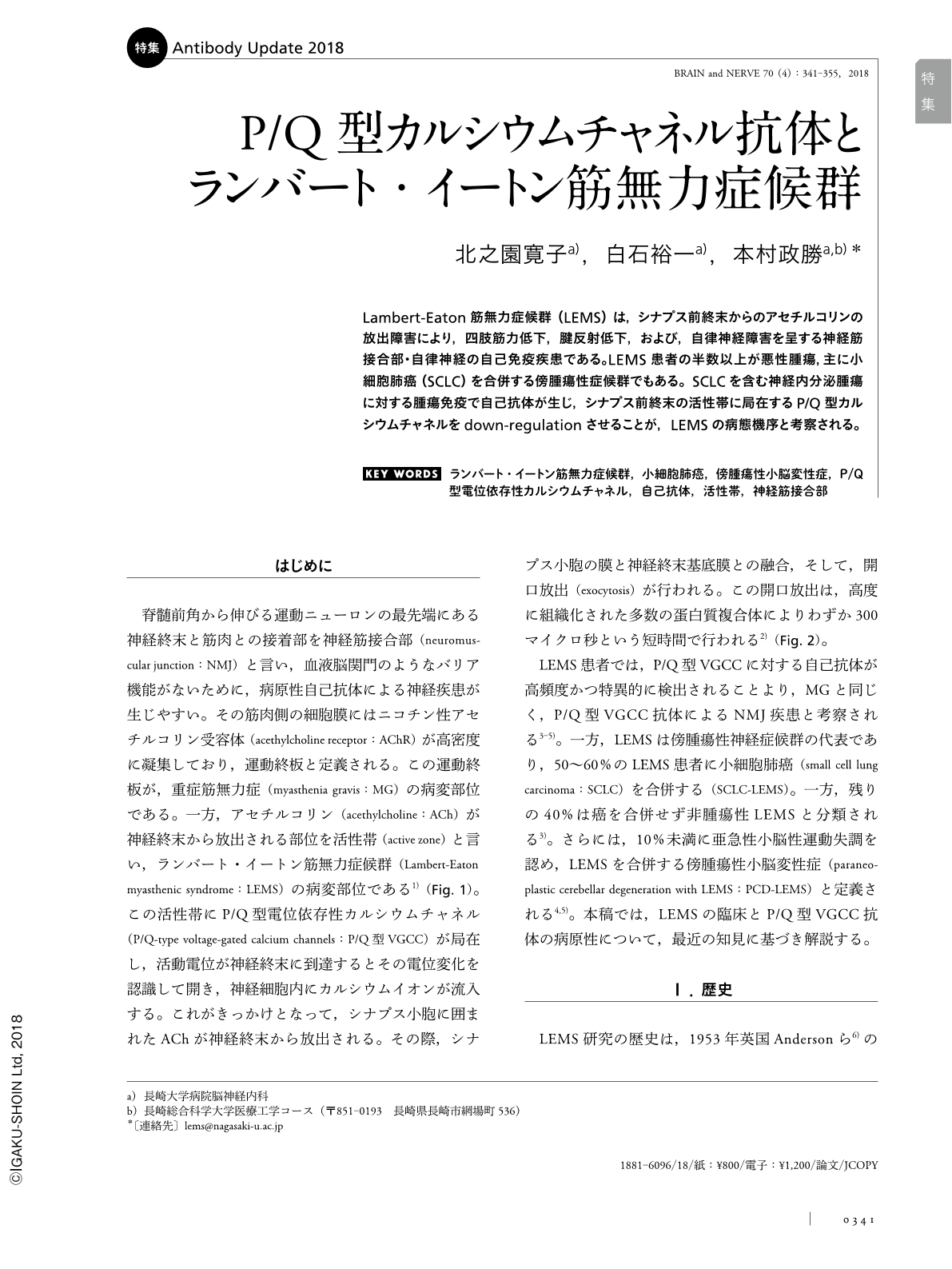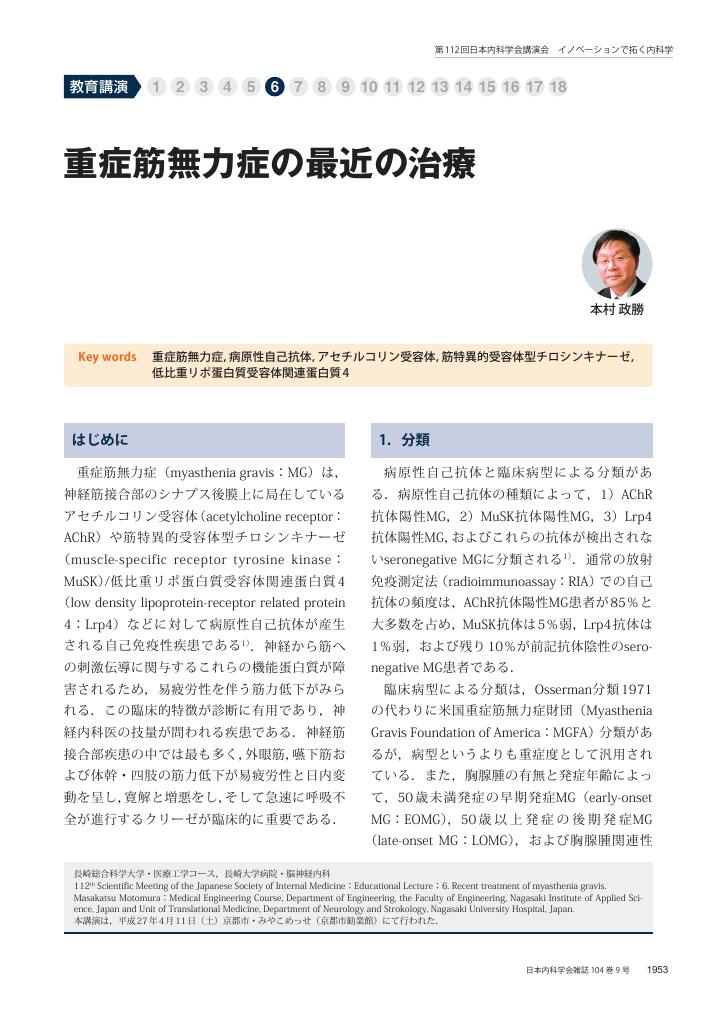1 0 0 0 OA 抗アセチルコリンレセプター抗体陰性の全身型筋無力症患者の病態
抗アセチルコリン受容体抗体(抗AChR抗体)および抗筋特異的チロシンキナーゼ抗体(抗MuSK抗体)共に陰性で筋無力症が疑われる患者の中に筋萎縮性側索硬化症もある。誘発筋電図でもWaningが認められ、テンシロンテストも陽性と判断されることがあり、抗体陰性の重症筋無力症の鑑別に重要と結論した。運動終板に補体C3の沈着が認められ、postsynaptic foldの減少も認められた。αバンガロトキシンの減少も認められる例もある。意義付けが困難であるが、眼筋型MGでは、AChR抗体が陰性のことが多く補体の沈着があることがある。測定感度以下のAChR抗体が関与する可能性や、AChR抗体以外の抗体の関与が考えられる。補体の沈着もなく、postsynaptic foldの減少があり、臨床像は、四肢近位筋の筋力低下があり、他の抗体もしくは、先天性の可能性など、今後の検討が必要である。ヒト抗MuSK抗体は、ラットの再生筋の運動終板においてもいても、ヒト運動終板と類似の変化をもたらす。 抗MuSK抗体は Postsynaptic areaの形成に影響を及ぼす。抗ラミニン抗体は抗体陰性の筋無力症の原因でありうる可能性を否定できないが、電気生理学的な検討も含めて、今後の検討が必要である。ラミニンも運動終板の形成に関与している可能性がある。
1 0 0 0 P/Q型カルシウムチャネル抗体とランバート・イートン筋無力症候群
- 著者
- 北之園 寛子 白石 裕一 本村 政勝
- 出版者
- 医学書院
- 雑誌
- BRAIN and NERVE-神経研究の進歩 (ISSN:18816096)
- 巻号頁・発行日
- vol.70, no.4, pp.341-355, 2018-04-01
Lambert-Eaton筋無力症候群(LEMS)は,シナプス前終末からのアセチルコリンの放出障害により,四肢筋力低下,腱反射低下,および,自律神経障害を呈する神経筋接合部・自律神経の自己免疫疾患である。LEMS患者の半数以上が悪性腫瘍,主に小細胞肺癌(SCLC)を合併する傍腫瘍性症候群でもある。SCLCを含む神経内分泌腫瘍に対する腫瘍免疫で自己抗体が生じ,シナプス前終末の活性帯に局在するP/Q型カルシウムチャネルをdown-regulationさせることが,LEMSの病態機序と考察される。
1 0 0 0 OA ニューキノロン系抗菌剤による痙攣の発症
- 著者
- 竹尾 剛 渋谷 統寿 本村 政勝 金沢 一 宍戸 春美
- 出版者
- 公益社団法人 日本化学療法学会
- 雑誌
- CHEMOTHERAPY (ISSN:00093165)
- 巻号頁・発行日
- vol.37, no.9, pp.1154-1159, 1989-09-25 (Released:2011-08-04)
- 参考文献数
- 8
ニューキノロン系抗菌剤と消炎鎮痛剤の併用により痙攣と高CK血症を来した症例を経験した。症例は64歳女性。膀胱炎のためエノキサシン (ENX) 300mg/日とフェンブフェン (FBF) 1,200mg/日を4日間服用中に突然意識消失し, 痙攣を来した。強直性痙攣と不穏状態が間歇的に3回繰り返し起こったが, 約4時間後には意識清明となった。入院時の心電図, 頭部CTスキャンは正常範囲であった。入院後著明な高CK血症 (第5病日に最高17,712IU/1と最高値) を認めたが第13病日には正常化した。CKアイソザイムはすべてMM型であったが, 針電極筋電図, 筋生検に異常はなかった。次に, マウスを用いてニューキノロン系抗菌剤による痙攣の発症に関する基礎実験を行なった。その結果ENXのみならず, シプロフロキサシンもFBFとの併用により痙攣を発症することがわかったが, オフロキサシンとFBFの併用では痙攣は発症しなかった。痙攣の予防に抗菌剤とFBFの投与前にあらかじめバルプロ酸ナトリウム, γ-アミノ-β-ヒドロキシ酪酸, プロスタグランディンE2, ジアゼパム, およびフェノパルピタールを投与したがいずれも痙攣の発症を抑えることはできなかった。ENXとFBFの併用による痙攣は現在まで7例が報告され, その主因はENXであろうと推定されているが, その機序は不詳である。
1 0 0 0 OA 6)重症筋無力症の最近の治療
- 著者
- 本村 政勝
- 出版者
- 一般社団法人 日本内科学会
- 雑誌
- 日本内科学会雑誌 (ISSN:00215384)
- 巻号頁・発行日
- vol.104, no.9, pp.1953-1958, 2015-09-10 (Released:2016-09-10)
- 参考文献数
- 10
- 被引用文献数
- 1
1 0 0 0 OA 教育講演15 自己免疫性神経筋接合部疾患の病態と治療
- 著者
- 本村 政勝
- 出版者
- 日本神経学会
- 雑誌
- 臨床神経学 (ISSN:0009918X)
- 巻号頁・発行日
- vol.51, no.11, pp.872-876, 2011 (Released:2012-01-24)
- 参考文献数
- 10
- 被引用文献数
- 4 5
The neuromuscular junction lacks the protection of the blood-nerve barrier and is vulnerable to antibody-mediated disorders. Myasthenia gravis (MG) is caused by the failure of neuromuscular transmission mediated by autoantibodies against acetylcholine receptors (AChR) and muscle-specific receptor tyrosine kinase (MuSK)/LDL-receptor related protein 4 which are AChR-associated transmembrane post-synaptic proteins involved in AChR aggregation. The seropositivity rates for AChR positive and MuSK positive MG in Japan are 80-85% and 5-10%/less than 1%,respectively. The incidence of late-onset MG, defined as onset after age 50 years, has been increasing worldwide. A nationwide epidemiological survey in Japan also revealed that the rates of late-onset MG had increased from 20% in 1987 to 42% in 2006. In 2010, a guideline for standard treatments of late-onset MG was published by the Japanese Society of Neurological Therapeutics. Lambert-Eaton myasthenic syndrome (LEMS) is an autoimmune disease of the neuromuscular junction and approximately 60% of LEMS patients have a tumor, mostly small cell lung cancer (SCLC), as a paraneoplastic neurological syndrome. The clinical pictures of Japanese LEMS patients are as follows; male dominant sex ratio (3 : 1), mean age 62 years (17-80 years), 61% of LEMS have SCLC, and the remaining are without cancer. In less than 10% of cases there are signs of cerebellar dysfunctions (paraneoplastic cerebellar degeneration with LEMS; PCD-LEMS) as well, often associated with SCLC. Most patients benefit from 3, 4-diaminopyridine plus pyridostigmine. In paraneoplastic LEMS, treatment of the tumor often results in neurological improvement. In non-paraneoplastic LEMS, prednisone alone or combined with immunosuppressants are treatment options. In both MG and LEMS, where weakness is severe, plasma exchange or intravenous immunoglobulin treatment may provide short-term benefit.
1 0 0 0 OA 重症筋無力症
- 著者
- 本村 政勝
- 出版者
- 日本神経治療学会
- 雑誌
- 神経治療学 (ISSN:09168443)
- 巻号頁・発行日
- vol.33, no.3, pp.318-322, 2016 (Released:2016-11-10)
- 参考文献数
- 10
Myasthenia gravis (MG) is an autoimmune neurological disorder characterized by impaired neuromuscular transmission due to circulating pathogenic autoantibodies. MG patients produce pathogenic autoantibodies against the acetylcholine receptors (AChR), muscle–specific receptor tyrosine kinase (MuSK), and low–density lipoprotein receptor–related protein 4 (Lrp4) which are localized on the postsynaptic membrane of the neuromuscular junction. This lecture provides the overview of MG in Japan including classification, epidemiology, autoantibodies, clinical manifestation, diagnosis, treatment, and prognosis, especially focusing on the new standard treatment approach according to novel MG diagnostic criteria suggested by the MG clinical guidelines for 2014. Treatments for MG are based on immunotherapy by steroids and immunosuppressants. In Japan, treatments include cholinesterase inhibitors, thymectomy, steroids, immunosuppressants, plasma exchange, and intravenous immunoglobulin therapy. However, even when utilizing all of these treatments, the proportion of MG patients achieving complete stable remission is less than 10%. The new treatment approach suggests the combination therapy from early disease stage, to reduce the risk of crisis and disease progression. The current goal of MG treatment is firstly to treat MG patients to achieve pharmacological remission as rapidly as possible using the above therapies at onset. The therapeutic protocol according to onset age, disease type, and pathogenic autoantibodies conducted in Nagasaki University Hospital is also discussed.
1 0 0 0 OA 新たな病因自己抗体、LRP4抗体陽性重症筋無力症の臨床像と神経筋接合部病態
LDL受容体関連蛋白質4(Lrp4)抗体陽性重症筋無力症(MG)の臨床像と神経筋接合部病態を解明し「アセチルコリン受容体(AChR)抗体と筋特異的受容体型チロシンキナーゼ(MuSK)抗体に次ぐ、第3番目の病因自己抗体になる」という理論仮説を検証した。我々はAChR抗体陰性MG患者から、Lrp4抗体を有する9症例を報告した(Ann Neurol. 2011)。その臨床像は、男女比4対5、発症平均年齢57歳、嚥下障害を主体とする全身型MGで胸腺腫の合併は無かった。神経筋接合部生検は、3例とも運動終板に免疫複合体の沈着は無く、電顕でも運動終板の破壊像は無くAChR抗体陽性MGとは異なるものであった。
1 0 0 0 OA 高齢発症重症筋無力症の標準的神経治療
- 著者
- 本村 政勝
- 出版者
- 日本神経学会
- 雑誌
- 臨床神経学 (ISSN:0009918X)
- 巻号頁・発行日
- vol.51, no.8, pp.576-582, 2011 (Released:2011-08-29)
- 参考文献数
- 27
- 被引用文献数
- 4 6
重症筋無力症(myasthenia gravis,MG)は自己抗体の種類によって,1)アセチルコリン受容体(acetylcholine receptor,AChR)抗体陽性MG,2)筋特異的受容体型チロシンキナーゼ(muscle-specific receptor tyrosine kinase,MuSK)抗体陽性MG,そして,3)前記の抗体が検出されないdouble seronegative MGに分類される.本邦では,MG全体の約80~85%が抗AChR抗体陽性で,残りの5~10%で抗MuSK抗体が検出される.近年,世界中で高齢発症MGの頻度が増加しており,MGはもはや高齢者の病気であるともいわれている.本邦の全国調査2006年では,50歳以上で発症したMG患者が1987年の20%から42%に増加したことが証明された.それにともなって,2010年日本神経治療学会から,高齢発症MGの診断と治療の考え方を示す標準的治療指針が公表された.その内容は,高齢発症MG治療に関してのかぎられたエビデンスと臨床報告や個々の経験から本標準的治療を,高齢発症のMGの疫学的特徴,その臨床症状の特徴,さらに,治療,すなわち胸腺摘出術の適応や副腎皮質ステロイド薬や免疫抑制薬の投与方法などについて記述されている.その要旨は,高齢発症のMG患者では,若年発症MGと比較して,眼筋型の比率が高かった.治療では,胸腺腫を合併しない高齢発症のMG患者では,若年発症MGと比較して胸腺摘除の適応は少なく,ステロイドの副作用をおさえるために少量のステロイドと免疫抑制薬の併用が標準的治療となる.

